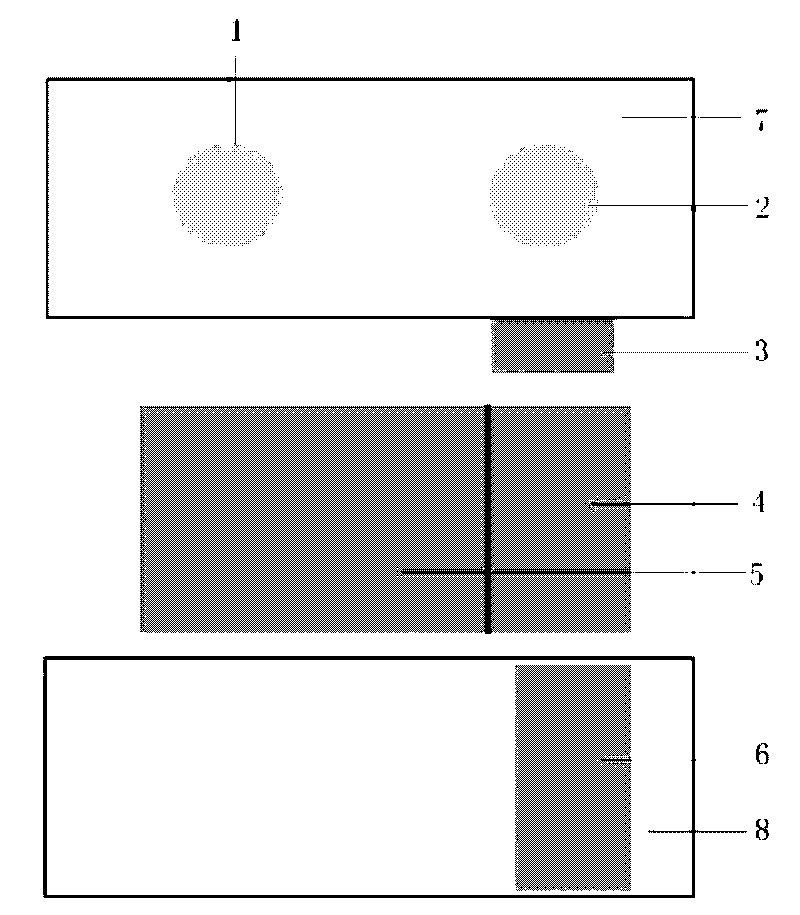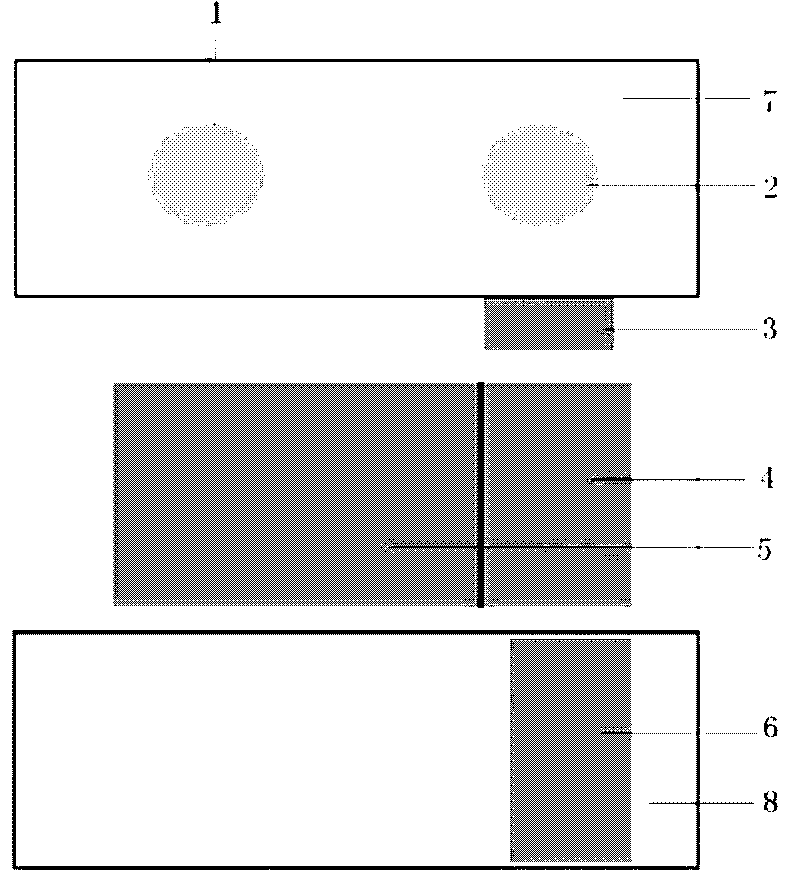Card for fast testing residual pesticide
A technology of residual pesticides and rapid test cards, which is applied in the field of rapid test cards for detecting residual pesticides, can solve problems such as dependence, low detection sensitivity, and insufficient response, and achieve the effects of sensitive detection, good anti-interference ability, and wide application range
- Summary
- Abstract
- Description
- Claims
- Application Information
AI Technical Summary
Problems solved by technology
Method used
Image
Examples
Embodiment 1
[0019] figure 1 It is a schematic structural diagram of the quick test card of the present embodiment, which is composed of figure 1 It can be seen that
[0020] The structure of the quick test card of the present embodiment is: the quick test card includes two layers of plastic plates; two holes are arranged on one of the plastic plates 7, one is the sample injection hole 1, and the other is the observation hole 2, and the diameters of the holes are 0.5cm;
[0021] One side of the plastic plate is pasted with absorbent paper 5 and an enzyme strip 4 fixed with Drosophila melanogaster acetylcholinesterase, the size of the absorbent paper is: long 20mm * wide 20mm, and the size of the enzyme strip is: long 20mm * wide 12mm, The amount of Drosophila melanogaster acetylcholinesterase immobilized on the enzyme strip is 3U, and the gelatin (prepared by dissolving gelatin in water) with a mass fraction of 0.4-1.2% is used for pasting; the absorbent paper 5 is opposite to the sample...
Embodiment 2
[0028] The quick test card of the present embodiment has the same structure as the embodiment, and the difference is that the diameters of the sampling hole and the observation hole are 0.7cm; the amount of Drosophila melanogaster acetylcholinesterase fixed by the enzyme strip is 4U; The amount of indoxyl acetate immobilized on the sheet was 8 mg; pasting was performed using 0.7% gelatin.
[0029] The process of using the test card to detect pesticide residues in samples is as follows:
[0030] Step 1, prepare a blank sample solution, the blank sample solution is 0.1mol / L PBK, its specific preparation process is as follows: take 12.48g dipotassium hydrogen phosphate, 3.85g potassium dihydrogen phosphate, dissolve in double distilled water to 1L, Adjust the pH value to 7.2 to obtain 1L of 0.1mol / L PBK;
[0031] Step 2: Add 0.5mL blank sample solution into the sample well, react at room temperature for 6 minutes, remove the baffle, and observe the color development result in th...
Embodiment 3
[0034] The quick test card of the present embodiment has the same structure as the embodiment, the difference is that: the diameter of the sample hole and the observation hole is 1cm; the amount of Drosophila melanogaster acetylcholinesterase fixed by the enzyme strip is 5U; the substrate The amount of indoxyl acetate immobilized on the sheet was 10 mg; pasting was performed using 1.2% gelatin.
[0035] The process of using the test card to detect pesticide residues in samples is as follows:
[0036] Step 1, prepare a blank sample solution, the blank sample solution is 0.1mol / L PBK, its specific preparation process is as follows: take 12.48g dipotassium hydrogen phosphate, 3.85g potassium dihydrogen phosphate, dissolve in double distilled water to 1L, Adjust the pH value to 7.2 to obtain 1L of 0.1mol / L PBK;
[0037] Step 2: Add 0.5mL blank sample solution into the sample well, react at room temperature for 6 minutes, remove the baffle, and observe the color development result...
PUM
 Login to View More
Login to View More Abstract
Description
Claims
Application Information
 Login to View More
Login to View More - R&D
- Intellectual Property
- Life Sciences
- Materials
- Tech Scout
- Unparalleled Data Quality
- Higher Quality Content
- 60% Fewer Hallucinations
Browse by: Latest US Patents, China's latest patents, Technical Efficacy Thesaurus, Application Domain, Technology Topic, Popular Technical Reports.
© 2025 PatSnap. All rights reserved.Legal|Privacy policy|Modern Slavery Act Transparency Statement|Sitemap|About US| Contact US: help@patsnap.com


